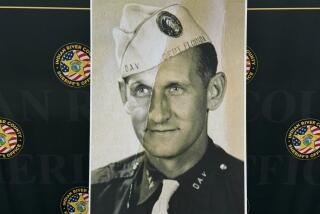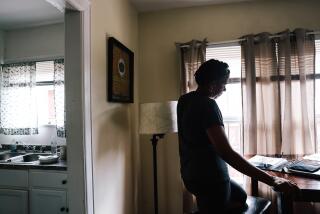An identical twin’s quest for the truth
They dressed alike, combed their hair the same way and had the same friends. They raided a neighbor’s henhouse and swiped eggs together. They even had crushes on the same girl.
The two 8-year-olds were playing near the corner of Crenshaw Boulevard and 236th Place on March 2, 1959, when Lynn Johnston tossed a bottle across the street and his brother Lyle ran to get it. Crossing back over Crenshaw, Lyle was hit by an Oldsmobile as Lynn watched in horror.
As he grew into adulthood, Johnston made a habit of explaining to people that his identical twin had been killed by a car, as if that would somehow explain who he was.
“Lyle’s death was like ripping me physically in two,” he said. “I’ve always told people that.”
Johnston eventually married and became a father. In 1987, he made a pilgrimage with his daughter to Torrance to show her where Lyle was killed and where he was buried. He snapped a photo of his daughter standing at the corner of Crenshaw and 236th holding a bouquet of flowers, which they later placed on Lyle’s grave.
He had always had questions about the accident and often wondered what had become of the Oldsmobile’s driver.
Two and a half years ago, he decided to find out.
In his quest to learn all about the case and whether justice was done, Johnston awakened painful memories for himself and others. He would learn that the legal process cannot heal emotional wounds, and that the echoes of that sunny afternoon would live as long as he does.
::
The twins lived in Lomita and were visiting their Aunt Gloria that day.
“Our mother often went there. As always, she told my brother Lyle and me not to go onto the road, since Auntie’s place sat on a residential street alongside a four-lane highway,” Johnston wrote years later in a college essay.
“Our cousins were having a nap, and being eight years old we were big enough that we no longer needed them. So we wandered outside on the front lawn, where my brother pulled out a small treasure, a pretty-colored glass bottle, from his pocket.
“I grabbed it from him and then him from me.... I tossed the bottle to the other side of the highway, not expecting Lyle to cross the street to get it. But he did. As he started, I yelled at him what mom had told us. ‘If you go across the street you’ll be killed,’ I said, hoping it would scare him into turning around.”
On his way back across the street, Lyle stopped to tie his shoe, kneeling in the traffic lane closest to the shoulder of the road, Johnston wrote. A car approached from about two blocks away, a gray, two-door 1955 Oldsmobile.
“The driver would surely see him and would turn to the left, to the right, or stop,” Johnston wrote in the essay. “The car had the whole road to itself. I watched frozen as the car bore down on Lyle, who wasn’t moving.
“I watched the front bumper hit Lyle’s head, throwing him into the air for what seemed like a half block.”
With Lyle gone, Lynn was lost. He withdrew from the world and frequently hid in closets. He had emotional outbursts in school and fell behind in his class work.
A psychologist convinced his parents to move the family from Lomita back to Washington state, where the Johnstons had previously lived.
Lynn continued to have problems in school and was placed in a remedial class. He had to repeat the third grade.
“I had nightmares for years. I was always afraid to be left alone,” said Johnston, now 60 and a telecommunications salesman living in Kingston, Wash., on Puget Sound northwest of Seattle. “I always had issues.”
As an adult, Johnston returned to Southern California to visit the Redondo Beach cemetery where his brother was buried. He discovered that the grave was unmarked. His family had been too poor to afford a headstone, so he paid for one.
“We miss you much, Lyle, while you sleep in death,” the inscription read. “Your twin brother, Lynn.”
The visit stirred something within Johnston. He was seized by a desire to learn more about the accident. In 2009, he contacted the Torrance Police Department and obtained a partial copy of the original accident report.
He was stunned to read the investigator’s conclusion: that although the death was accidental, the driver should be held “criminally responsible,” for failing to yield to a pedestrian. No charges were ever filed, however.
Johnston knew his parents had reached a $10,000 settlement in a lawsuit they had filed against the driver, but this was the first hint that a crime might have been committed.
A month later, Johnston went to Torrance to search for more records and obtain a copy of the complete police report. At the same time, he had his brother’s remains exhumed, cremated and placed in a Brazilian rosewood box that he could take back to Washington.
Reading over the full police report, Johnston learned that the driver had said Lyle ran in front of her car, and that she had swerved and honked her horn in an attempt to avoid him.
The driver told police that Lyle was standing near the corner and when she got within about 25 feet of him, he “suddenly started to run across the street.” Then he lost his shoe and stopped, she said. “He turned and faced me for just a second, and then ran back into the front of my car,” the driver said, according to the police report.
She said she had been going about 30 mph. An investigator’s diagram shows skid marks left when the Oldsmobile swerved.
In the report, Johnston saw more than a sterile recitation of facts. To him, it appeared the driver had tried to blame his brother.
He also learned that an autopsy had been performed and a coroner’s inquest held “to secure information for the use of all law enforcement agencies charged with the prosecution of criminal offenses.”
Studying the coroner’s files, Johnston saw that the inquest concluded that the driver was “probably criminally responsible” for the boy’s death.
“The full light bulb came on in my head. The driver should have been charged with vehicular homicide or manslaughter,” Johnston said.
Back in Washington, he spoke with his mother, Frances, now 78 and the only other surviving member of what had been a family of six. She recounted how Lynn had run into the kitchen that day, screaming, and how she had rushed out the front door to find Lyle lying in the street, motionless.
In January, Johnston returned to Torrance. He tracked down the 1959 civil lawsuit file, dug up old newspaper stories about the accident and studied maps and satellite photos of the accident site. He returned to the scene and took his own pictures.
He asked around Torrance, hoping to find anyone who might remember the accident. And he found someone.
Torrance Mayor Frank Scotto vividly recalled the tragedy.
“I was a child and I lived a block away from where it happened. I used to cross Crenshaw every day, collecting bottles,” Scotto said. “I remember it well. When you’re 10 years old like I was, something like that makes an impression. It stifled my bottle-collecting. We feared crossing that street after that.”
During his January visit, Johnston brought copies of the 1959 paperwork to ask authorities to reopen the case and file charges against the driver.
Torrance Police Investigator Tim Coffey interviewed Johnston and reviewed his department’s original report. It was impossible to determine how fast the Oldsmobile was going at the time of the accident, Coffey said.
The original investigators concluded that the driver had violated the California Vehicle Code by failing to yield to a pedestrian in a crosswalk, even though it was unmarked, Coffey wrote Jan. 26 in a supplemental report to the 1959 investigation.
Yet Coffey could not find any documentation indicating that the case was ever referred to the district attorney’s office.
“Based on my review of the traffic accident, the supplemental reports and speaking with the victim’s brother, Lynn Johnston, I am submitting this case to the Los Angeles District Attorney’s office for possible filing of criminal charges,” he wrote.
It took about three hours for prosecutors at the district attorney’s branch office in Torrance to review Johnston’s thick packet of information and Coffey’s report.
Even if the facts warranted criminal charges, the statute of limitations has expired, deputy district attorney Haralambos Zoumberakis said. Charges would have to have been filed within three years of the accident, he said.
Johnston was discouraged but says he isn’t giving up.
“There was no official action on this back in 1959,” he said. “Who dropped the ball?”
Legal experts said Johnston faces steep obstacles in pursuing the case.
Although there are circumstances in which the statute of limitations does not apply, in this case “I think the district attorney is probably correct,” said Pepperdine University Law School professor Carol Chase, a former federal prosecutor.
“There are a lot of issues about punishing people after all these years have passed.”
Johnston had a lingering need to know what had happened to the driver. He tracked her down in Rancho Palos Verdes. Renee Radinsky is 83 now, and she made clear to police that she did not want to talk to Johnston.
During his January visit, he drove past her home without stopping. But before returning to Washington, he mailed copies of the 1959 police report and the coroner’s findings to Radinsky and her adult children.
“I wanted to give them the truth,” he said.
Reached by a reporter, Radinsky said she saw no point in revisiting the past.
“It was 52 years ago. It was an accident. It was resolved,” she said. “I don’t want to talk about it.”
The case is closed, she indicated. Everyone should move on.
More to Read
Start your day right
Sign up for Essential California for news, features and recommendations from the L.A. Times and beyond in your inbox six days a week.
You may occasionally receive promotional content from the Los Angeles Times.







